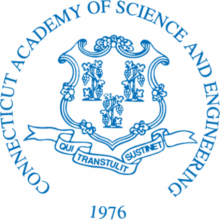What do the James Bond movie Goldfinger, Tom Clancy’s novel, The Cardinal of the Kremlin and the United Technologies Research Center have in common? They are all loves of Tony DeMaria’s, because they encourage the exploration of science and laser technology. Dr. DeMaria came to America from Italy when he was five years old, grew up in a tough Waterbury neighborhood, and worked construction jobs to help his family and support his education. His father was a janitor with limited education and his mother was a garment worker with no education. He struggled to learn English, had a stutter, and didn’t fit in well until 8th grade. In spite of these challenges, he went on to become one of Connecticut’s greatest contributors to scientific advancement and technology. To what does he owe his success? To a fascination with science that as a youngster included geology and astronomy, and to his family physician, who in 1950 advised him to study electronics, “an exploding field” after World War II. This advice led Dr. DeMaria to his favorite hobby and lifelong career: laser research.
Dr. DeMaria graduated from the University of Connecticut in 1956 with a degree in electrical engineering. He began his first job, working on radar applications for Anderson Laboratories. It wasn’t long before he realized that applied physics was his true passion; he began attending night classes at Rensselaer Polytechnic Institute in Hartford, earning a Masters Degree in Science. A turning point in his life occurred in 1959, when he read Nobel laureate Charles Townes’s theoretical paper on lasers; this encouraged him to enroll in a PhD program in both electronics and physics at UConn. His 1965 thesis led to his greatest breakthrough — generating picosecond laser pulses, whose time durations lasted the time it takes light to travel the thickness of a sheet of paper. These ultra-fast laser pulses made it possible to probe atoms and molecules and measure their relaxation rates, a discovery that led to overnight fame and his election to the National Academy of Engineering, the National Academy of Sciences, and as president of the Optical Society of America. He is a founding member of the Connecticut Academy of Science and Engineering and a member of the Connecticut Academy of Arts and Sciences.
In 1994, Dr. DeMaria retired from United Technologies to start DeMaria ElectroOptics Systems, LLC (DEOS) with the purpose of transferring laser radar technology to commercial use. In 2001, DEOS was acquired by Coherent, Inc, becoming Coherent-DEOS, LLC located in Bloomfield, where he serves as chief scientist. He is very proud of his company, which has created over 200 new jobs in Connecticut and exports over 75% of its laser products worldwide. He continues to make valuable contributions to the scientific community as he sees his role “progressing from scientist to manager to entrepreneur.” Dr. DeMaria has been awarded 55 patents and continues to develop new ideas.
“Technology is what makes the world go around,” says Dr. DeMaria. “Countries with good technology are the global economic leaders.” He believes that unfortunately “many Americans are intimidated by science and technology, which are not only very important fields for keeping us competitive in a world market, but are also fields of great interest, reward and excitement.” Dr. DeMaria tells young people not to “believe that people in technology are the nerds portrayed on television and in movies. Scientists and engineers contribute greatly to the economic health and well-being of the world, while enjoying life and having fun too!”


